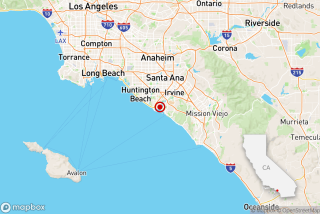California tsunami advisory: What you need to know
- Share via
A small tsunami off the California coast is expected to stem from the massive Chile earthquake that struck Wednesday evening. Officials are not expecting significant damage or flooding.
Here are the basics:
How large will the tsunami be?
Officials estimate less than one foot. By contrast, the 2011 California tsunami caused by the great Japan quake caused swells of up to 6 feet, resulting in major damage up and down the coast, and one death.
Here is a more detailed forecast from the National Oceanic and Atmospheric Administration:
Santa Monica: 0.8 feet
Middle Harbor (at the Ports of Los Angeles and Long Beach): 1 foot
Seal Beach: 0.8 feet
Huntington Beach: 0.7 feet
Newport Beach: 0.4 feet
Laguna Beach: 0.4 feet
Dana Point: 0.2 feet
Avalon: 0.1 feet
Two Harbors: 0.3 feet
Malibu: 0.6 feet
Port Hueneme: 0.5 feet
Where will the tsunami hit and when?
The tsunami advisory extends from San Onofre State Beach in San Clemente, about 55 miles north of San Diego, to Ragged Point, about 50 miles north of San Luis Obispo, according to the National Tsunami Warning Center.
National weather officials expect the tsunami will begin to affect the California coast about 4:46 a.m. in Newport Beach and travel swiftly, arriving a minute later in the Port of Los Angeles. By 5:06 a.m., the tsunami will arrive in Santa Barbara, and by 5:10 a.m., in the Port San Luis.
Have other quakes in Chile caused California tsunamis?
Yes, but they have been relatively small. There was a minor event in 2014 after a 8.2 quake in Chile. There was damage and flooding to California coastal locations including Morro Bay, Ventura, Crescent City and San Diego in 2010 from a tsunami event from an 8.8 Chile quake.
What precautions are being taken?
Officials are urging people to avoid the beach Thursday morning.
While Thursday morning’s tsunami won’t pose a significant safety risk, there are some basic general tips for tsunami safety. These were compiled by Orange County public safety officials:
- Turn on your radio to learn whether a tsunami advisory has been issued if an earthquake occurs and you are in a coastal area.
- Move inland, to higher ground, immediately and stay there.
- Stay away from the beach. Never go down to the beach to watch a tsunami come in. If you can see the wave, you are too close to escape it.
- If there is noticeable recession in water away from the shoreline, this is nature’s tsunami advisory and it should be heeded. You should move away immediately.
How bad can California tsunamis get?
In recent years, the worst occurred in Crescent City after a quake in Alaska. The tsunami killed 11 people and destroyed 289 homes and businesses.
Can I surf on the tsunami?
Unfortunately, no. The word “tsunami wave” conjures images of a massive, breaking wave. But a tsunami wave lacks a face and appears more like a “wall of whitewater,” giving nothing for a surfboard to catch, according to researchers at the University of Hawaii at Hilo.
For news about tsunamis and other happenings in California, follow @MattHjourno and @ShelbyGrad.
More to Read
Sign up for Essential California
The most important California stories and recommendations in your inbox every morning.
You may occasionally receive promotional content from the Los Angeles Times.














